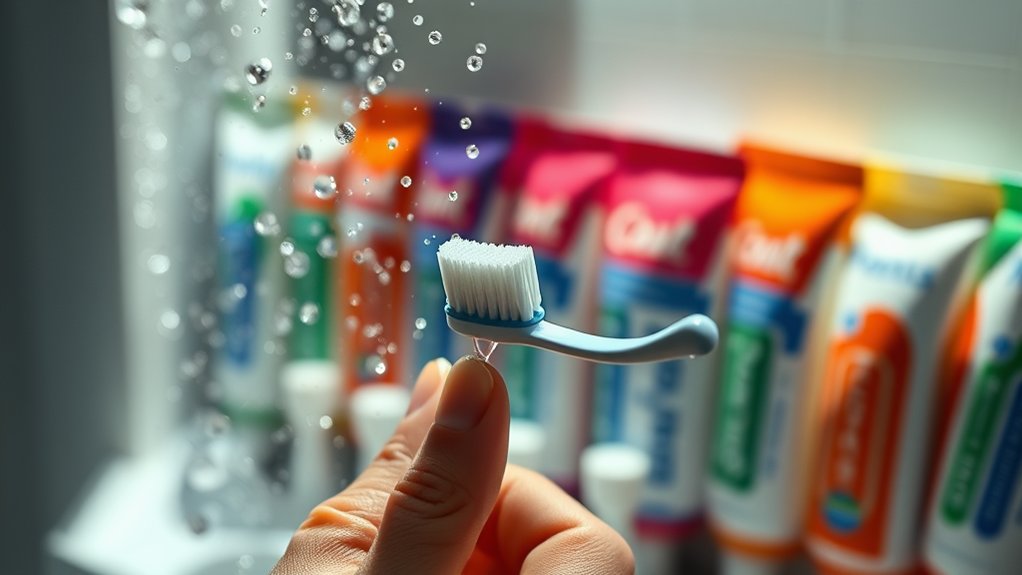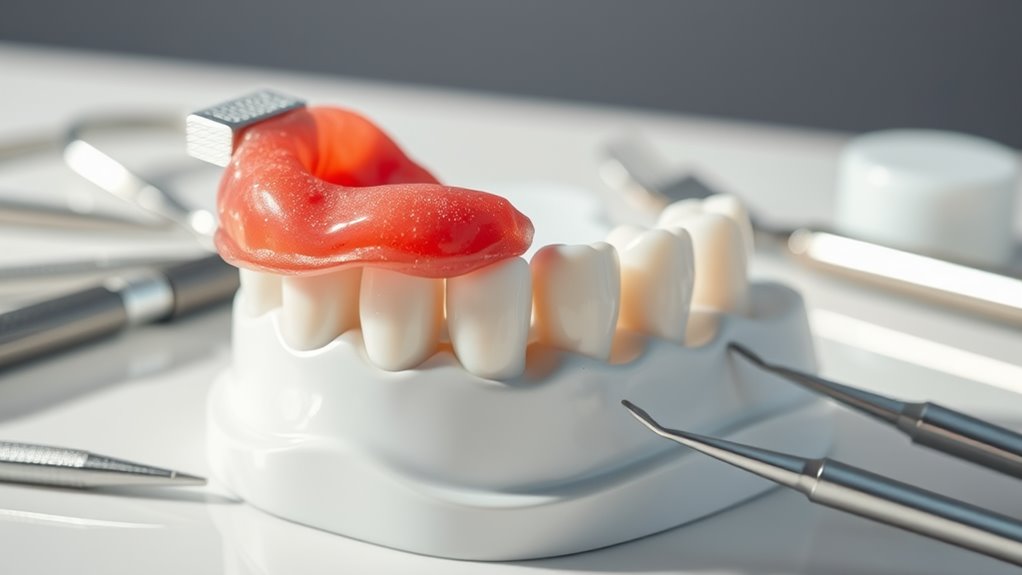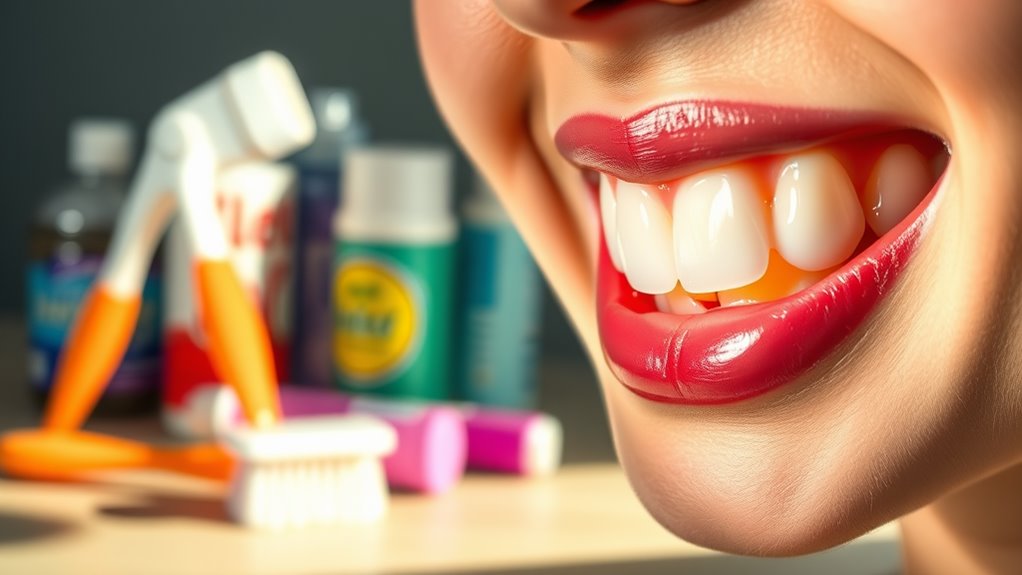Can You Brush Too Much. The Answer May Surprise You
You might think that brushing your teeth more often or with extra pressure leads to a healthier smile, but that’s not always the case. Overbrushing can actually cause serious issues like enamel wear and gum recession. It’s crucial to understand the right techniques and routines to keep your mouth healthy without causing harm. Curious about how to strike that perfect balance and safeguard your dental health? Let’s explore this surprising topic further.
Key Takeaways
- Overbrushing can erode tooth enamel and cause gum recession, leading to increased sensitivity and decay risk.
- Signs of overbrushing include tooth pain, receding gums, and changes in gum color such as redness and swelling.
- The American Dental Association recommends brushing gently twice a day for two minutes with a soft-bristled toothbrush to prevent damage.
- Proper brushing techniques, including using a 45-degree angle, help maintain oral health without causing harm.
- Regular dental check-ups and consultations are vital for personalized advice and early detection of potential issues related to overbrushing.
Understanding Overbrushing
While you may think that more brushing leads to better oral hygiene, overbrushing can actually do more harm than good.
Overbrushing facts reveal that this practice can erode tooth enamel and lead to gum recession, causing sensitivity and pain. In your quest for a clean mouth, you might overlook that brushing too often or too forcefully can harm your teeth and gums. Aggressive brushing can disrupt enamel’s crystalline structure at a microscopic level, leading to potential damage.
The American Dental Association recommends brushing twice a day for two minutes with a soft-bristled toothbrush.
Understanding the balance between effective brushing and overbrushing is essential for maintaining optimal oral health without causing unintended damage.
Signs of Overbrushing
If you’re experiencing pain or sensitivity in your teeth and gums, it might be a sign that you’re overbrushing.
Additional indicators include receding gums, which can expose tooth roots, and enamel wear, leading to increased vulnerability.
You may also notice a rough or scratched feeling on your gums, indicating irritation.
Changes in the color of your gums, such as redness or swelling, can signal inflammation due to excessive brushing.
If you find yourself needing to brush more frequently to feel clean, it’s essential to reassess your technique and frequency to avoid further damage to your oral health. Bleeding gums can also signal underlying inflammation related to overbrushing and dental care practices.
Effects on Enamel and Gums
Overbrushing can lead to significant wear and tear on your enamel, making your teeth more vulnerable to decay. It also increases the risk of gum recession, which can expose the roots of your teeth and cause sensitivity. Understanding the ideal brushing frequency is essential to maintain optimal oral health without damaging your enamel and gums. Furthermore, aggressive brushing can harm gums, leading to irritation and recession.
Enamel Wear and Tear
Brushing your teeth is essential for maintaining oral hygiene, but excessive pressure or frequency can lead to significant enamel wear and unintended consequences for your gums.
Enamel protects your teeth from decay, and once lost, it doesn’t regenerate. Over-brushing wears it down, making your teeth more sensitive to temperature changes and increasing the risk of cavities.
Additionally, aggressive brushing can damage the gums, leading to irritation and discomfort. It’s important to use soft bristles and gentle techniques.
Striking a balance in your brushing routine ensures healthy enamel and gums, contributing to long-term oral health without unnecessary damage.
Gum Recession Risks
While maintaining good oral hygiene is vital, neglecting the pressures applied during brushing can trigger gum recession, a condition that poses risks both to your gums and enamel.
When gums recede, they expose the sensitive roots of your teeth, increasing vulnerability to decay and sensitivity. This exposure can also lead to enamel wear, as the unprotected areas become more susceptible to acid attacks and erosion.
Additionally, gum recession can create pockets that harbor harmful bacteria, further compromising your oral health.
It’s essential to ensure your brushing technique is gentle to protect both your gums and enamel long-term.
Ideal Brushing Frequency
Finding the right balance in your oral care routine is key for protecting both your gums and enamel. Brushing too often can lead to wear and sensitivity, while brushing too infrequently can result in plaque buildup and gum disease.
Aim for an effective frequency with these guidelines:
- Brush twice daily to remove plaque and food particles.
- Use a soft-bristled toothbrush to minimize enamel wear.
- Limit brushing to two minutes per session for thorough cleaning.
- Consider replacing your toothbrush every three months for optimal results.
Recommended Brushing Techniques
To maintain optimal oral health, it’s essential to use proper brushing techniques. You should focus on the right angles and follow recommended frequency guidelines to effectively clean your teeth without causing harm. Additionally, being aware of common brushing mistakes can help you improve your technique and enhance your overall oral hygiene routine.
Proper Brushing Angles
When it comes to effective tooth brushing, understanding proper angles can significantly enhance your oral hygiene routine. Using the right techniques can maximize plaque removal while protecting your gums.
Here are four recommended angles:
-
45-Degree Angle: Position your brush towards the gum line to effectively reach plaque beneath it.
-
Vertical Strokes: For front teeth, use gentle up-and-down motions to cover all surfaces.
-
Circular Motions: Use small, circular movements on chewing surfaces for thorough cleaning.
-
Tilted Brush: Angle your brush slightly when cleaning the back teeth for better reach.
Incorporating these angles will improve your brushing effectiveness.
Frequency Guidelines
Although brushing your teeth regularly is essential for maintaining oral health, knowing how often to do it can make all the difference. The American Dental Association recommends brushing twice a day for two minutes each time. However, brushing too aggressively or too frequently can harm your enamel and gums.
| Frequency | Time Duration |
|---|---|
| Twice Daily | 2 minutes each |
| After Meals | Optional (1-2 min) |
| Before Bed | Must Do |
| As Needed | Avoid Excessive |
Follow these guidelines to strike the right balance in your oral care routine!
Finding the Right Balance
Finding the right balance in your dental care routine is essential for maintaining optimal oral health.
Over-brushing can lead to enamel erosion and gum irritation, while under-brushing may result in plaque buildup. To achieve this balance, consider the following:
-
Brush twice a day: Stick to a consistent routine to prevent cavities.
-
Use a soft-bristled toothbrush: This minimizes damage to your enamel and gums.
-
Replace your toothbrush regularly: A worn-out brush is less effective.
-
Incorporate flossing: This helps remove food particles and plaque from between your teeth.
Additionally, ensure you’re spending enough time brushing—aim for at least two minutes to effectively clean your teeth!
Tips for Healthy Oral Hygiene
Maintaining healthy oral hygiene is crucial for preventing dental issues and promoting overall well-being.
Brush your teeth twice a day with fluoride toothpaste, using gentle circular motions to avoid enamel wear. Don’t forget to clean between your teeth daily with floss or interdental brushes to remove plaque where a toothbrush can’t reach.
Rinse with an antibacterial mouthwash to reduce bacteria and freshen breath. Regular dental check-ups are essential for early detection of issues. Incorporate tongue cleaning into your routine to enhance your oral health and reduce bad breath.
Limit sugary snacks and drinks, as they can lead to cavities. Lastly, stay hydrated; water helps rinse your mouth and promotes saliva production for natural protection.




